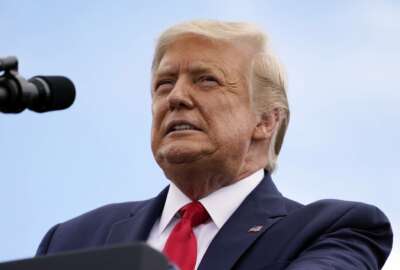Guess what costs $200 billion and requires 131 million hours?
The Biden administration exceeded the record of its two predecessors in one respect. Namely, the number and estimated costs of the regulations issued in the first...
Best listening experience is on Chrome, Firefox or Safari. Subscribe to Federal Drive’s daily audio interviews on Apple Podcasts or PodcastOne.
The Biden administration exceeded the record of its two predecessors in one respect. Namely, the number and estimated costs of the regulations issued in the first year. That’s according to a tally made by a senior regulatory policy analyst at the right-leaning American Action Forum. Dan Goldbeck joined the Federal Drive with Tom Temin.
Interview transcript:
Tom Temin: Mr. Goldbeck, good to have you on.
Dan Goldbeck: Thanks for having me, Tom.
Tom Temin: So tell us what you have discovered and counting regulations issued, I guess you can look at them in terms of pages, in terms of the manpower required by industry to carry them out, and in what they’ll cost. So tell us what you found.
Dan Goldbeck: Sure. So over here at American Action Forum, we have this project called Reg Rodeo, where we track all the regulations that come through the Federal Register, with data going back to 2005. Now, with the Biden administration passing its first year or so, we’re able to compare it to at least the Trump administration, the Obama administration in terms of what were they doing in their first year. And what we found, particularly in terms of the costs, that the agencies themselves estimate, the Biden administration is far exceeding its two predecessors in terms of regulatory costs, as well as also paperwork that’s imposed by these regulations.
Tom Temin: And what are the regulatory costs so far?
Dan Goldbeck: So an updated version of it has the Biden administration with about 200 billion in regulatory costs and about 131 million hours of paperwork each year, as opposed to Trump, the total was about $5 billion in costs and 8 million hours. And for Obama was about 65 million in costs, and 50 million hours. And so you’re seeing a just massive increase compared to the past two administrations. Part of that is because of a couple pretty major rules. But you’re seeing a pretty continuous trend line in that direction.
Tom Temin: And a major rule threshold, I believe, is $10 billion?
Dan Goldbeck: It’s is $100 million.
Tom Temin: 100 million. OK, wow, I was way ahead of that. And so what are the couple biggest ones that contribute the most to this $200 billion figure?
Dan Goldbeck: So perhaps the most significant one was the Biden administration’s version of vehicle emission standards that hit late last year that contributed the vast majority of the cost to this total. Another significant role was the OSHA vaccine mandate, that’s actually since then stayed by the Supreme Court, but it imposed the largest amount of paperwork by about 80 million hours there.
Tom Temin: Wow. So even in having it rescinded by the Supreme Court, a lot of the cat is out of the bag for industries that tried to comply, because they couldn’t wait for the Supreme Court.
Dan Goldbeck: Up until this point with the Supreme Court say this just based on the agency’s own analysis of what it would potentially impose. I’m not sure exactly how much got implemented in that sense. But that’s what the agency said it was going to impose, so.
Tom Temin: Right, because in making a regulation, they have to state the estimated cost, in terms of industry paperwork burden, and cost also, and dollars expended. Now, this 200 billion and 130 million hours in the first year, I guess it’s possible, then theoretically, that they could be very light on regulations for the next three years. And we do know what Obama did in the first four years there and what Trump did in those four years. So there’s a chance this could all kind of average out?
Dan Goldbeck: There is a possibility for that in terms of checking from even just by year one report from last month, checking the Obama administration total, the paperwork there is kind of been creeping up and catching it. And particularly if you take out that one OSHA rule, they’re getting closer to parity there. But I think you’re going to see still continued increase as much as the administration can, because as we’ve seen in these past couple administrations, when they can’t get their major items to Congress, regardless of which direction of going in terms of the policy, that they turn to these executive actions and regulations to try to implement their policies as much as they can. And I think that just given the trends politically in this country, you’re going to see the Biden administration go down that route, more and more.
Tom Temin: We’re speaking with Dan Goldbeck. He’s senior regulatory policy analyst at the right leaning American Action Forum. And when the different agencies proposed these regulations, there’s a process for rulemaking that they have to do. Do you have any sense of the imposition of time and effort on the agencies proposing the rules? Because these take a lot of effort?
Dan Goldbeck: Yeah, I mean, the basic process is agency proposes a role and then they have a limited period of time where they fight public comment, and then they go over those comments. They’re legally required to consider them all. And some of those rules can get hundreds of thousands of comments. And so that, obviously, is a pretty big imposition on the agencies to review all those comments or at least get a sense of what direction they’re pushing towards and incorporating those contributions into the final version that usually comes, you know, a few months down the line
Tom Temin: And let’s switch to executive orders for a minute because you’ve tally those up, too. And we remember some of the television images of these big stacks of beautiful binders and nice pens, the president looking dapper signed with a lot of fanfare. What’s the numbers there? It looks like there’s a history of large numbers of EOs going back quite a few years.
Dan Goldbeck: For that area, we actually have a lot more data going farther back in history. And what we find is that in its first year, President Biden has signed more EOs than at least going back to the Ford administration. So that’s going on 50 years or so of precedent. And so you’re just seeing in that sense, the regulations can be very granular. The executive orders, though, are the broad sort of statements of policy, as you sort of speak to you in terms of having the pomp and circumstance to them. And so to the extent that you’re seeing this increased volume, it again, points to this continuing trend towards executive action versus legislation, because Congress is so intractable at the moment,
Tom Temin: right, it looks like the leader of executive orders in the first year was Dwight D. Eisenhower, which would have been back in 1953. And, in general, the first number of orders, undo the orders of the prior administration, presuming the party changes.
Dan Goldbeck: That’s increasing now, because you saw a decent amount from Trump in his first year, too. And so a lot of that is orders from Biden reversing those. And also, as we know, in the report, a number of them, of course, we’re dealing primarily with the whole COVID situation. And so there’s a little bit of historical anomalies, but still, I think it’s a notable trend.
Tom Temin: But if you look at George H.W. Bush, that was the real piker there, he only came in with about 35 in the first year. Clinton and George W. Bush were about matched, you know, a few plus or minus, but then you really get this yo-yo effect between Obama to Trump to Biden, I get the sense that could continue if the party changes again.
Dan Goldbeck: the yo yo factors you put is a really apt description for how the whole administrative process goes these days in terms of these administration’s basically putting all their chips into executive actions that, unlike legislation, are that much more ephemeral in terms of a new party comes into power, and they can just swipe away so much of the previous party’s agenda in that sense.
Tom Temin: And probably industry just wishes for stability, even if there are lots of regulations, if they could count on some kind of normalcy continuing from administration to administration. That’s probably what they want more than necessarily a reduction of regulation, per se.
Dan Goldbeck: Yeah, you hear a lot from industry folks, that having this sort of up and down thing really messes with them trying to plan out 5, 10 years ahead in terms of their business plan, and so it’s certainly important consideration.
Tom Temin: Alright, Dan Goldbeck is senior regulatory policy analyst at the right of center American Action Forum. Thanks so much for joining me,
Dan Goldbeck: Thank you so much, Tom.
Copyright © 2025 Federal News Network. All rights reserved. This website is not intended for users located within the European Economic Area.
Tom Temin is host of the Federal Drive and has been providing insight on federal technology and management issues for more than 30 years.
Follow @tteminWFED






